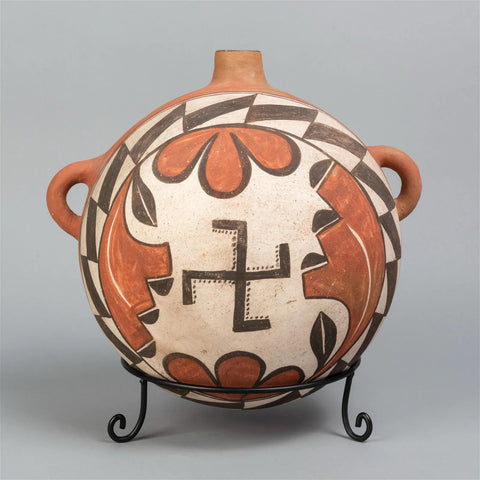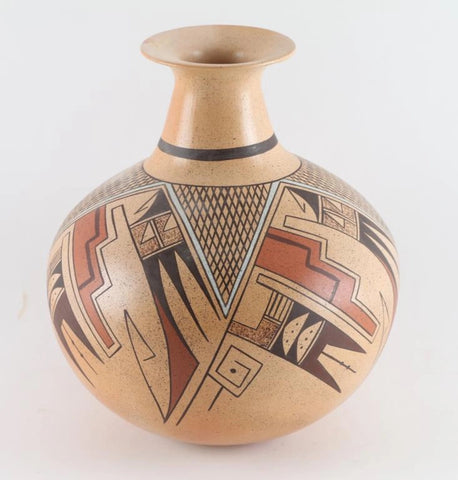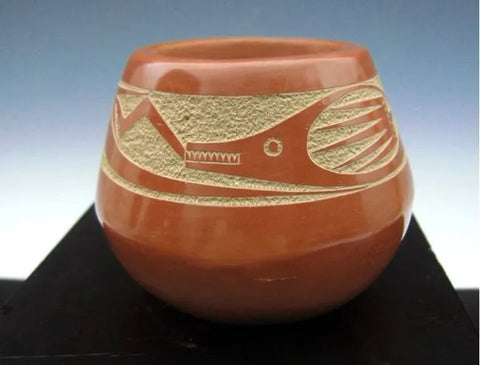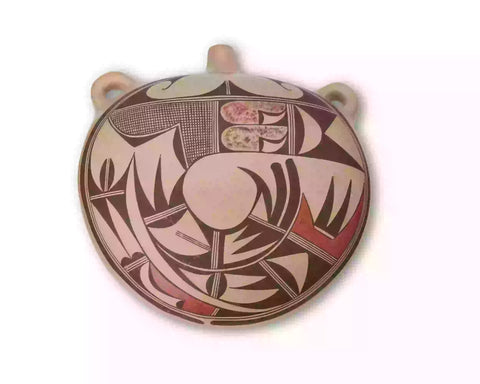Home
>
Native American Indian Pottery
>
Prehistoric Sinagua Plain Ware Pottery Bowl, Ca. 1100-1275 AD, #1524

Prehistoric Sinagua Plain Ware Pottery Bowl, Ca. 1100-1275 AD, #1524
$ 1,800.00
Prehistoric Sinagua Plain Ware Pottery Bowl, Ca 1100-1275 AD, #1524
Description: #1524 Prehistoric Sinagua Plain Ware Pottery Bowl, Ca 1100-1275 AD. Hand coiled and polished plain ware pottery bowl as found condition.
Dimensions: 4.5'' x 9.5''
Condition: Excellent for age.
Provenance: Reportedly deaccessioned from the El Paso Museum of the Old West.
The Sinagua Culture evolved in a small area of central Arizona, extending from the area around Flagstaff south into the Verde Valley near Sedona.
Characteristics: The eruption of Sunset Crater in 1064 distributed a layer of ash over much of this area, and people were soon drawn to the much-improved growing conditions. The result was a mixture of Hohokam, Anasazi and Mogollon influences that never fully merged into a single distinctive culture. The character of Sinagua culture varied from site to site, depending on the degree of influence from the various other groups. Pottery construction, house types and the existence of ball courts all point to the Hohokam as the first settlers. Superficial similarities in the appearance of pottery with Mogollon types may be as much due to a commonality of raw materials rather than the importation of technology. Perhaps the best definition of the Sinagua is that it is none of the other major cultures and all of them at the same time.
House Types: Early Sinagua sites consist of shallow pithouses or surface dwellings with wooden upper parts. Later sites are more typical of the Anasazi surface pueblos, sometimes ranged around a kiva.
Pottery: The pottery of the Sinagua is primarily plain ware, their painted wares being merely copies of contemporary local types. The earliest plain wares were much like Alma Plain of the Mogollon, except that they were made using the paddle-and-anvil method, and forms are more reminiscent of Hohokam types. Paddle-and-anvil construction was apparently the first technology introduced here, suggesting that it was the Hohokam who first expanded into this territory. (Source: Museum of Northern Arizona)
________________________________________
A History of Pueblo Pottery:
“Pueblo pottery is made using a coiled technique that came into northern Arizona and New Mexico from the south, some 1500 years ago. In the four-corners region of the US, nineteen pueblos and villages have historically produced pottery. Although each of these pueblos use similar traditional methods of coiling, shaping, finishing and firing, the pottery from each is distinctive.
Various clay's gathered from each pueblo’s local sources produce pottery colors that range from buff to earthy yellows, oranges, and reds, as well as black. Fired pots are sometimes left plain and other times decorated—most frequently with paint and occasionally with appliqué. Painted designs vary from pueblo to pueblo, yet share an ancient iconography based on abstract representations of clouds, rain, feathers, birds, plants, animals and other natural world features.
Tempering materials and paints, also from natural sources, contribute further to the distinctiveness of each pueblo’s pottery. Some paints are derived from plants, others from minerals. Before firing, potters in some pueblos apply a light colored slip to their pottery, which creates a bright background for painted designs or simply a lighter color plain ware vessel. Designs are painted on before firing, traditionally with a brush fashioned from yucca fiber.
Different combinations of paint color, clay color, and slips are characteristic of different pueblos. Among them are black on cream, black on buff, black on red, dark brown and dark red on white (as found in Zuni pottery), matte red on red, and polychrome—a number of natural colors on one vessel (most typically associated with Hopi). Pueblo potters also produce undecorated polished black ware, black on black ware, and carved red and carved black wares.
Making pueblo pottery is a time-consuming effort that includes gathering and preparing the clay, building and shaping the coiled pot, gathering plants to make the colored dyes, constructing yucca brushes, and, often, making a clay slip. While some Pueblo artists fire in kilns, most still fire in the traditional way in an outside fire pit, covering their vessels with large potsherds and dried sheep dung. Pottery is left to bake for many hours, producing a high-fired result.
Today, Pueblo potters continue to honor this centuries-old tradition of hand-coiled pottery production, yet value the need for contemporary artistic expression as well. They continue to improve their style, methods and designs, often combining traditional and contemporary techniques to create striking new works of art.” (Source: Museum of Northern Arizona)
----------
View the other items in my shop: http://www.etsy.com/shop/CulturalPatina?ref=shopsection_shophome_leftnav
Description: #1524 Prehistoric Sinagua Plain Ware Pottery Bowl, Ca 1100-1275 AD. Hand coiled and polished plain ware pottery bowl as found condition.
Dimensions: 4.5'' x 9.5''
Condition: Excellent for age.
Provenance: Reportedly deaccessioned from the El Paso Museum of the Old West.
The Sinagua Culture evolved in a small area of central Arizona, extending from the area around Flagstaff south into the Verde Valley near Sedona.
Characteristics: The eruption of Sunset Crater in 1064 distributed a layer of ash over much of this area, and people were soon drawn to the much-improved growing conditions. The result was a mixture of Hohokam, Anasazi and Mogollon influences that never fully merged into a single distinctive culture. The character of Sinagua culture varied from site to site, depending on the degree of influence from the various other groups. Pottery construction, house types and the existence of ball courts all point to the Hohokam as the first settlers. Superficial similarities in the appearance of pottery with Mogollon types may be as much due to a commonality of raw materials rather than the importation of technology. Perhaps the best definition of the Sinagua is that it is none of the other major cultures and all of them at the same time.
House Types: Early Sinagua sites consist of shallow pithouses or surface dwellings with wooden upper parts. Later sites are more typical of the Anasazi surface pueblos, sometimes ranged around a kiva.
Pottery: The pottery of the Sinagua is primarily plain ware, their painted wares being merely copies of contemporary local types. The earliest plain wares were much like Alma Plain of the Mogollon, except that they were made using the paddle-and-anvil method, and forms are more reminiscent of Hohokam types. Paddle-and-anvil construction was apparently the first technology introduced here, suggesting that it was the Hohokam who first expanded into this territory. (Source: Museum of Northern Arizona)
________________________________________
A History of Pueblo Pottery:
“Pueblo pottery is made using a coiled technique that came into northern Arizona and New Mexico from the south, some 1500 years ago. In the four-corners region of the US, nineteen pueblos and villages have historically produced pottery. Although each of these pueblos use similar traditional methods of coiling, shaping, finishing and firing, the pottery from each is distinctive.
Various clay's gathered from each pueblo’s local sources produce pottery colors that range from buff to earthy yellows, oranges, and reds, as well as black. Fired pots are sometimes left plain and other times decorated—most frequently with paint and occasionally with appliqué. Painted designs vary from pueblo to pueblo, yet share an ancient iconography based on abstract representations of clouds, rain, feathers, birds, plants, animals and other natural world features.
Tempering materials and paints, also from natural sources, contribute further to the distinctiveness of each pueblo’s pottery. Some paints are derived from plants, others from minerals. Before firing, potters in some pueblos apply a light colored slip to their pottery, which creates a bright background for painted designs or simply a lighter color plain ware vessel. Designs are painted on before firing, traditionally with a brush fashioned from yucca fiber.
Different combinations of paint color, clay color, and slips are characteristic of different pueblos. Among them are black on cream, black on buff, black on red, dark brown and dark red on white (as found in Zuni pottery), matte red on red, and polychrome—a number of natural colors on one vessel (most typically associated with Hopi). Pueblo potters also produce undecorated polished black ware, black on black ware, and carved red and carved black wares.
Making pueblo pottery is a time-consuming effort that includes gathering and preparing the clay, building and shaping the coiled pot, gathering plants to make the colored dyes, constructing yucca brushes, and, often, making a clay slip. While some Pueblo artists fire in kilns, most still fire in the traditional way in an outside fire pit, covering their vessels with large potsherds and dried sheep dung. Pottery is left to bake for many hours, producing a high-fired result.
Today, Pueblo potters continue to honor this centuries-old tradition of hand-coiled pottery production, yet value the need for contemporary artistic expression as well. They continue to improve their style, methods and designs, often combining traditional and contemporary techniques to create striking new works of art.” (Source: Museum of Northern Arizona)
----------
View the other items in my shop: http://www.etsy.com/shop/CulturalPatina?ref=shopsection_shophome_leftnav
Related Products
Sold out













